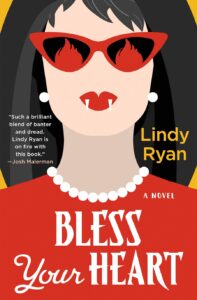When I first started writing Bless Your Heart and the Evans women, it was a goodbye letter, not the start of a new series. I’d recently lost my grandmother to a brief but brutal sickness, and not long before that, my great-grandmother in one of those sudden-but-expected sorts of ways. With my mother battling a chronic illness and my once-strong matriarchal family scattered to the wind, I found myself in an existential free-fall: I’d grown up on the wings of these strong, capable, passionate women, and suddenly they were all gone.
Craving one more adventure with those grandmothers I’d loved so much, I decided to bring them back. Unfortunately, my powers of necromancy are tragically limited, and so I did the next best thing a horror girl like me could do, and took to the page to write a story about four generations of women who did their best to keep their town’s dead—and their own family secrets—buried.
Coming up with the idea for a horror story baked through with blood-drenched humor, monster-fighting grannies, and a trip back through the millennial heyday of the late-nineties? That part was easy. But figuring out how to build a world big enough to home a fictional small-town that blended mystery and monsters with Southern charm and girl power, and to then invite everyone in town to help tell the tale? Different story.
Enter that old adage: “Write what you know.” I’ve never really liked those four limiting little words, though I remain a fan of Ursula K. Le Guin’s take on them. She said,
“As for ‘Write what you know,’ I was regularly told this as a beginner. I think it’s a very good rule and have always obeyed it. I write about imaginary countries, alien societies on other planets, dragons, wizards, the Napa Valley in 22002. I know these things. I know them better than anybody else possibly could, so it’s my duty to testify about them. I got my knowledge of them, as I got whatever knowledge I have of the hearts and minds of human beings, through imagination working on observation. Like any other novelist. All this rule needs is a good definition of ‘know.’”
While alien societies are one of many things that I don’t know anything about, I do know a thing or two about surrounding myself with women who’d fight to the teeth for one another, blood or not, about growing up in a once-upon-a-boomtown in the late-nineties rural South, and about finding myself in that family, in that town, at that time.
And so, bless my heart, I started by writing what I knew.
Not that it was easy, mind you. Several elements made introducing the Evanses’ world difficult: a multi-POV cast, a mythology rooted in really old and unkempt folklore, and tragic, centuries-old events in both my real hometown’s history as well as those that made worldwide headlines in 1999. Add a mystery, and writing a Big Story in a Small Town became a Tall Order.
I knew I wanted to make each of the four Evans women a Big character with her own POV. A good ensemble can be so satisfying and dynamic, giving readers multiple characters to connect with and layers of rich story texture—but it’s hard to get right. Each Evans woman needed her voice, her own quirks, and each needed to have a clear role in the family’s legacy. Beyond the main characters, everyone in the world needed to be fully realized. In a series, those secondary and tertiary characters have a habit of finding their way into major plot lines sooner or later.
I’m a sucker for Small Stuff, and I wanted to infuse the Evans women with glimpses of my real family. Luckily, I had a lot of memories to build out Ducey, Lenore, Grace, and Luna. My great-grandmother was never without a dog-eared Harlequin novel and a pocket full of butterscotch candies; my clock-collecting nana could often be found wandering her own home, forever winding; and my terribly clumsy mother, well, our “Grace” really does have that silver scar on her wrist. With the littlest Evans an amalgamation of my closest childhood friends in our teenage glory days, Luna became a Frankengirl of her own.
I tucked into my arsenal of favorite characters from literature and film, studied what I loved most about them, and let them inspire the world too: Olympia Dukakis’s brilliant portrayal of Chinquapin Parish’s Clairee Belcher (Steel Magnolias) mixed with the canonical horsepower of Bram Stoker’s Mina Harker (Dracula) helped bring Mina Jean Murphy back from the dead; Edgar Allan Poe’s “Lenore” gave Lenore Evans her name while a character study of Toni Collette’s filmography informed her personality; and, because I’m a professor and enjoy poking fun at fellow pedagogues, Washington Irving’s willowy Ichabod Crane (“The Legend of Sleepy Hollow”) coupled with British comedian Noel Fielding’s affable weirdness made me giggle every time I wrote a scene with this town’s newest student, Crane Campbell.
With the characters in place, I needed a world to put them in, and there’s no hometown I know better to write about than my own. Though I’ve left the familial nest, like many Southern families, the rest of us Evanses have lived in Southeast Texas ever since my great-great-whatever-grandparents came to America. Along with long genealogies, small rural towns on the Texas-Louisiana border are a gumbo of people and ideas.
I wrote about as much of it as I knew, and then some.
Some of the book’s settings are based on real locations, while others blend inspiration and imagination. My grandfather, like Bless Your Heart’s Edwin Boone, once worked at the Fair Store. When I was in high school, my mom and I lived in a garage apartment, but not over a laundromat. We went to the same high school too, but it wasn’t called Forest Park when I went there like it was when she did. And you can’t write a book in Southeast Texas without mentioning Blue Bell Ice Cream, and my favorite discontinued flavor, Fruit Special. All those Small details added up to build a Big small-town—and I “knew” every one.
In addition to the place, there’s also the timing to consider, and what a year was 1999! The music! The movies! The eyeliner! 1999 saw the birth of the Chanel Vamp urban legends, the apocalyptic fears of Y2K. If you were alive in 1999, you lived through those small moments, just like you remember the many big bleak events that ended the nineties grungy crime streak. The Columbine High School massacre. The Clinton impeachment trials. Shakespeare in Love won the Academy Award, but the rest of the world was gunfire and natural disaster.
And so was my tiny little sliver of real life. Social mores of late-nineties Texas were social mores of late-nineties Texas, and I was a weird goth kid with all the scars to prove it. A friend committed suicide after coming out of the closet that year, another got killed by a drunk driver. Bi-polar meds were shoved down rebellious teenage throats. I spent an entire day in the principal’s office because all of us who wore Hot Topic clothing found death threats in our lockers. The KKK still carried a known presence. Billboards lined a ten-mile stretch of highway, bullet-pointing the details of a local cold case of a murdered woman. And as much as I know late-nineties Southeast Texas, I know monsters.
Enter the strigoi.
When I’m asked about my love of monsters, a favorite story to tell is the one about how I dusted a copy of Interview with the Vampire off a flea market bookstore as a kid and fell in love. But it’s never been the romance, the fangs, or even the glitz, glamour, and sometimes even glitter of these fanged heartthrobs that’s called to me—it’s the history, and it’s the sadness, and it’s the othering. It’s all well and good to sleep away the day in cozy coffins and skulk around in capes at night, but doing it year after year, decade after decade, century after century, watching everything you know and love perish and rot, only to become a solitary predator in the darkness of your own never-ending monstrousness?
Yikes. Blood drinking aside, that’s some horror, right there.
Being in academia has taught me the merits of good research, which served me well both in researching the real history of my actual hometown to tangle it all up with that of the Evanses’ family lore, and in digging into undead myths of the past. Before Dracula, before Carmilla, other types of blood drinkers gorged themselves in folklore—roaming, mindless, restless things, like strigoi. A primitive predecessor to the more modern vampire, strigoi, like those the Evans women face, are risen dead. Most rise from improper burials, but some rise from trauma or contagion and others for no good reason at all, other than hunger. In these old myths, the restless strigoi is less a fanged charmer than it is a ghoul eager to sink its teeth into whatever part of its victim it can.
And if there’s anything undead I love more than vampires, it might be zombies.
In the end, all those things I knew, both Big and Small, became Bless Your Heart. I’ve had a heck of a last adventure with my grandmothers, and now, I hope readers will make some good old-fashioned guts and glory memories with the Evans Women.
So, my advice: follow Ursula’s lead. Write what you know—especially if you know monsters.
***


















